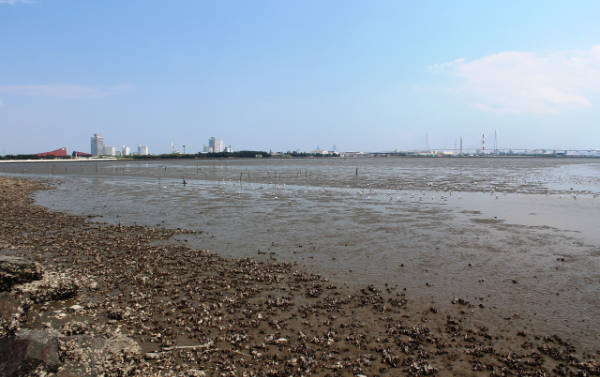AICHI – Beloved Wisdom 愛知県

“Aichi” is another prefectural name whose origin of the verbal word (pronunciation) and written word (kanji characters) stem from different histories. They don’t match up, so the real meaning and origin remain a mystery.
Based on the current kanji characters meaning love (Ai) and intelligence/knowledge/wisdom (chi), we know the literal meaning of “Aichi,” but nobody knows exactly what they signify or refer to even though both kanji characters have a good meaning. An obvious case of ateji kanji used for phonetic purposes with little regard for the meaning.
During the Kamakura Period (1185–1333), “Aichi” was written as 愛智 (Love and Wisdom) as well as 愛知 as used today. Eventually, the latter became the norm and current kanji.
As a word, “Aichi” is thought to have evolved from the word Ayuchi (年魚市) which was the name of tidal flats along the waterfront in present-day Atsuta-ku, Nagoya. Atsuta Shrine, one of Japan’s most famous Shinto shrines, was once on the waterfront. The tidal flat has since been reclaimed along with a large swath of Nagoya’s waterfront since the Edo Period (17th to 19th c.).
The Ayuchi tidal flat is mentioned in the 8th century Man’yoshu book of poetry in a waka poem by Takechi no Kurohito (高市黒人):
「桜田へ鶴鳴き渡る年魚市潟(あゆちがた)潮干にけらし鶴鳴き渡る」
Modern Japanese: 桜田へ鶴が鳴き渡ってゆくよ。年魚市潟は潮が引いたらしい。鶴が鳴き渡ってゆくよ“Honking white birds on their way to Sakurada. Ayuchi-gata tidal flats now at low tide. Honking birds are flying across it.”
–Man’yoshu
*Although the Japanese literally mentions tsuru (cranes), it actually referred to any white bird.
Sakurada was a waterfront area in present-day Moto-Sakurada-cho (元桜田町) east of Atsuta-ku in Nagoya. Sakurada is no longer a waterfront nor tidal flat.
In 1871, after the samurai domains were abolished, Owari Province (excluding Chita District) became Nagoya Prefecture, later merged with Inuyama Prefecture. Mikawa and Chita merged to form Nukata Prefecture (額田県) consisting of Toyohashi, Okazaki, and Kariya.
In April 1872, Nagoya Prefecture was renamed Aichi Prefecture after Aichi District where the prefectural capital was located. In Nov. 1872, Nukata Prefecture merged into Aichi Prefecture to form the prefecture we know today.

In the 1950s during Japan’s high economic growth period, Nagoya’s tidal flats saw further land reclamation to create an industrial belt. Only a small area of tidal flats has remained at Fujimae-higata (藤前干潟) at the mouth of Shonai, Shinkawa, and Nikko Rivers in the Nagoya Port area. It is noted for migratory birds and other wildlife. It’s also listed as a Ramsar site for wetlands.
In 1984, plans to reclaim Fujimae-higata tidal flat were announced. It was to become a landfill of garbage since the city’s garbage dump would soon reach capacity. This spurred a citizens group to organize and protest the reclamation plans in 1987. The protest movement gathered enough steam and environmental impact evidence to have the reclamation plans cancelled in Dec. 1998.
The local government and residents then made utmost efforts to recycle and reduce their trash. They succeeded in greatly reducing the amount of garbage to be buried, thereby extending the garbage dump’s service life.
Turns out that their love (Ai 愛) for the environment led to a wise and intelligent (chi 知) solution.
*Shiga Prefecture also has the same kanji characters (愛知) as Aichi for the name of a district, former village/town, river, shukuba lodging town on the old Nakasendo Road, and local train station. However, it’s pronounced “Echi” instead of “Aichi.”
There’s Echi-gun District (愛知郡), Echigawa-cho/mura (愛知川村・町), Echigawa River (愛知川), Echigawa-juku (愛知川宿), and Echigawa Station (愛知川駅). The name’s origin seems to be unrelated to Aichi.
Old province names: Owari-no-Kuni, Mikawa-no-Kuni (尾張国+三河国).
Sources: https://chubu.env.go.jp/wildlife/mat/m_1_1_11_1.html
https://fujimae.org/fujimae-tidal-flat-conserved/
https://www.pref.aichi.jp/global/en/summary/profile/background.html
*The AI-generated image is for illustrative purposes only and may not accurately depict any particular place in the prefecture.
Origin of other prefectural names (etymologies)
Overview | Aichi | Akita | Aomori | Chiba | Ehime | Fukui | Fukuoka | Fukushima | Gifu | Gunma | Hiroshima | Hokkaido | Hyogo | Ibaraki | Ishikawa | Iwate | Kagawa | Kagoshima | Kanagawa | Kochi | Kumamoto | Kyoto | Mie | Miyagi | Miyazaki | Nagano | Nagasaki | Nara | Niigata | Oita | Okayama | Okinawa | Osaka | Saga | Saitama | Shiga | Shimane | Shizuoka | Tochigi | Tokushima | Tokyo | Tottori | Toyama | Wakayama | Yamagata | Yamaguchi | Yamanashi